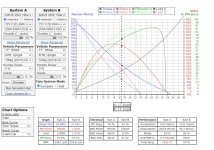MadRhino
100 GW
Limited to 25kw short bursts and 4kw continuous. Higher weight and/or aero drag, along with slower riding habits, would require setting lower limits.
mbgjt1 said:John in CR said:Get a 3t in a 13" scooter rim, which works out to a 19.25-20" OD wheel depending upon the tire you buy. That or a fast wind 273 if you want to go spokes and a bit larger wheel like a 17". If all your riding is on roads that are in good condition, then the size of the wheel and weight of the motor don't really matter. I run almost exclusively 13" scooter wheels with motors that weigh 15.5kg before the relatively heavy tire and allow mag rim, and while the tire can skip a bit on choppy roads, the tire size and motor weight are really a non-issue. I too live in a mountainous country and have the fastest bikes on the forum.
You haven't mentioned what all up load (bike+rider), which is of critical importance.
Hey mate, all up the weight would be 70 kg plus 60 so 130 kg all together.
I've never considered going down to a such a small size, I wonder if it will look strange compared to the front wheel.
I really would love to use the QS273 but it seems like the added weight causes too many issues especially off road on trails, i'll also have to invest in stronger overall components so the cost may sky rocket.
For a single person weighing 70 kg I would think that the QS205 motor is the best option.
mbgjt1 said:We've got very steep hills around here, majority being between 10 and 12 degrees (around 18%).
Another way to ask the question, with a QS205 coupled to a 17" wheel, what is the worst gradient it can handle before overheating?
E-HP said:...You could try different winds of the MXUS in the simulator to get an idea about the trade off between top speed and ability to climb without meltdown...
John in CR said:E-HP said:...You could try different winds of the MXUS in the simulator to get an idea about the trade off between top speed and ability to climb without meltdown...
I don't know how many times I need to tell you guys before it will soak in...Winds don't make any difference at all other than to change the combination of voltage and current to achieve exactly the same result. Due to the inherent voltage limitations of common controllers the only difference is that slower winds are slower lower power motors. They don't climb hills any better and they don't make more torque. In fact it is more common for a slow wind motor to get burned up, because their current limits are so much lower that it's easier to burn them up.

ZeroEm said:The QS205 is a 50mm wide motor is it not. The Cromo was made to pull the mountains and it's a 50mm, would that not be a closer match to compare?
E-HP said:[attachment=0]
https://ebikes.ca/tools/simulator.html
markz said:Move the 04 motor's throttle in the sim down to 71% and the curves and speed are the same.
https://ebikes.ca/tools/simulator.html?motor=MX4504_SA&batt=cust_72_0.2_40&cont=cust_250_500_0.03_V&hp=0&wheel=17i&grade=15&axis=mph&cont_b=cust_250_500_0.03_V&motor_b=MX4506_Ferro&batt_b=cust_72_0.2_40&wheel_b=17i&hp_b=0&grade_b=15&bopen=true&autothrot_b=false&autothrot=false&throt=71&throt_b=100
E-HP said:[attachment=0]
https://ebikes.ca/tools/simulator.html
